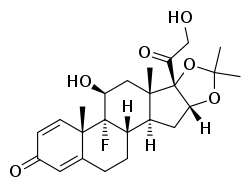Triamcinolone acetonide
Triamcinolone acetonide is a synthetic corticosteroid used topically to treat various skin conditions, to relieve the discomfort of mouth sores, and intra-articularly by proceduralists to treat various joint conditions.[1] In nasal spray form, it is used to treat allergic rhinitis. It is a more potent derivative of triamcinolone, and is about eight times as potent as prednisone.[2]
 | |
.png) | |
| Clinical data | |
|---|---|
| Other names | 9α-Fluoro-16α-17α-isopropyledenedioxyprednisolone; 9α-Fluoro-16α-hydroxyprednisolone 16α,17α-acetonide; 9α-Fluoro-11β,16α-17α,21-tetrahydroxypregna-1,4-diene-3,20-dione cyclic 16,17-acetal with acetone; 9α-Fluoro-11β,21-dihydroxy-16α,17α-isopropylidenedioxypregna-1,4-diene,3,20-dione |
| Routes of administration | Topical, joint injection |
| Identifiers | |
| |
| CAS Number | |
| PubChem CID | |
| IUPHAR/BPS | |
| ChemSpider | |
| UNII | |
| ChEBI | |
| ChEMBL | |
| CompTox Dashboard (EPA) | |
| ECHA InfoCard | 100.000.863 |
| Chemical and physical data | |
| Formula | C24H31FO6 |
| Molar mass | 434.504 g·mol−1 |
| 3D model (JSmol) | |
| |
| |
| | |
It is also known under the brand names Kenalog (topical) and Volon A as an injection, to treat allergies, arthritis, eye diseases, intestinal problems, and skin diseases.
In 2014, the FDA made triamcinolone acetonide an over-the-counter drug in the United States in nasal spray form under the brand name Nasacort.[3]
Medical uses
Triamcinolone acetonide as an intra-articular injectable has been used to treat a variety of musculoskeletal conditions. When applied to the skin as a topical ointment, it is used to mitigate blistering from poison ivy, oak, and sumac,. When combined with Nystatin, it is used to treat skin infections with discomfort from fungus, though it should not be used on the eyes.[4] It provides relatively immediate relief and is used before using oral prednisone. Oral and dental paste preparations are used for treating aphthous ulcers.
As an intravitreal injection, triamcinolone acetonide has been used to treat various eye diseases and has been found useful in reducing macular edema.[5] Drug trials have found it to be as efficient as anti-VEGF drugs in eyes with artificial lenses over a two-year period. A systematic review did not find any evidence of any benefit in preventing vision loss in eyes treated with triamcinolone acetonide over placebo, for patients with age-related macular degeneration.[6]
Triamcinolone acetonide is also administered via intralesional injection in the treatment of hypertrophic and keloid scars.[7][8]
Uncommonly, intramuscular injection of triamcinolone acetonide may be indicated for the control of severe or incapacitating allergic states for which conventional treatments have failed, such as asthma, atopic dermatitis, contact dermatitis, perennial or seasonal allergic rhinitis, serum sickness, and transfusion and drug hypersensitivity reactions.
Contraindications
As with all immunosuppressant drugs, triamcinolone acetonide should not be taken by people suffering from infectious diseases, either currently or in recuperation or soon thereafter. Contact with infectious people should be avoided during the entire course of treatment. Users who contract an infection during their regimen should contact their doctors to discuss whether to discontinue triamcinolone acetonide.
Triamcinolone acetonide should not be taken if the patient is also taking any other steroid or immunosuppressant, or if they have recently undergone any medical procedures involving the administration of steroids (e.g. nerve block).
Evidence suggests that usage of triamcinolone acetonide or other steroids to treat macular edema increases the risk of increasing intraocular pressure in patients.[9]
Many drugs have been demonstrated to increase triamcinolone acetonide concentration in the blood to well above the intended level. Patients should inform doctors about any other drugs they are taking.
Triamcinolone acetonide should not be used by those with tuberculosis or untreated fungal, bacterial, systemic viral or herpes simplex infections without consulting a doctor first.
Pharmacology
Pharmacodynamics
Triamcinolone acetonide is a corticosteroid. It is specifically a glucocorticoid, or an agonist of the glucocorticoid receptor.
Chemistry
Triamcinolone acetonide, also known as 9α-fluoro-16α-hydroxyprednisolone 16α,17α-acetonide or as 9α-fluoro-11β,16α-17α,21-tetrahydroxypregna-1,4-diene-3,20-dione cyclic 16,17-acetal with acetone, is a synthetic halogenated cyclic ketal pregnane corticosteroid.[10] It is the C16α,17α acetonide of triamcinolone.[10]
Veterinary use
Triamcinolone acetonide is also used in veterinary medicine as an ingredient in topical ointments and in topical sprays for control of pruritus in dogs.[11] A series of injections with triamcinolone acetonide or another corticosteroid may reduce keloid size and irritation. It is used as a preinductor and/or inductor of birth in cows. It was also used in the horse racing industry, but it is now a banned substance if found in a horse's system on race day.[12]
See also
- Topical steroid relative strength groupings list
References
- Triamcinolone Acetonide Drug information from MedLine Plus
- Nasacort medication leaflet
- Nasacort.com
- "Nystatin And Triamcinolone (Topical Route)". mayoclinic.org. Mayo Foundation for Medical Education and Research. Retrieved 18 May 2016.
- Grover DA, Li T, Chong CCW (2008). "Intravitreal steroids for macular edema in diabetes". Cochrane Database Syst Rev (1): CD005656. doi:10.1002/14651858.CD005656.pub2. PMC 3804331. PMID 18254088.CS1 maint: multiple names: authors list (link)
- Geltzer A, Turalba A, Vedula SS (2013). "Surgical implantation of steroids with antiangiogenic characteristics for treating neovascular age-related macular degeneration". Cochrane Database Syst Rev (1): CD005022. doi:10.1002/14651858.CD005022.pub3. PMC 4269233. PMID 23440797.CS1 maint: multiple names: authors list (link)
- "Intralesional Steroid Therapy (Patient Information Leaflets)". British Association of Dermatologists. Archived from the original on 15 March 2020. Retrieved 15 March 2020.
- Griffith, B.H. (1966). "The treatment of keloids with triamcinolone acetonide". Plastic and Reconstructive Surgery. 38 (3): 202–208. doi:10.1097/00006534-196609000-00004. PMID 5919603.
- Gewaily D, Muthuswamy K, Greenberg PB (2015). "Intravitreal steroids versus observation for macular edema secondary to central retinal vein occlusion". Cochrane Database Syst Rev. 9 (9): CD007324. doi:10.1002/14651858.CD007324.pub3. PMC 4733851. PMID 26352007.
- J. Elks (14 November 2014). The Dictionary of Drugs: Chemical Data: Chemical Data, Structures and Bibliographies. Springer. pp. 1228–. ISBN 978-1-4757-2085-3.
- GENESIS® (triamcinolone acetonide) Topical Spray Drug information
- Champion Hurdle favourite Yanworth failed drug test